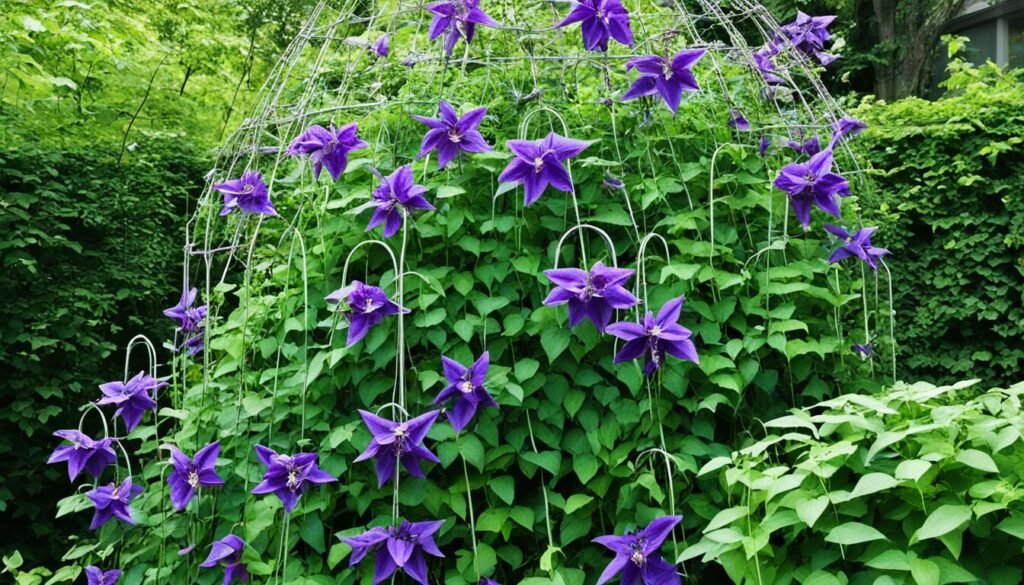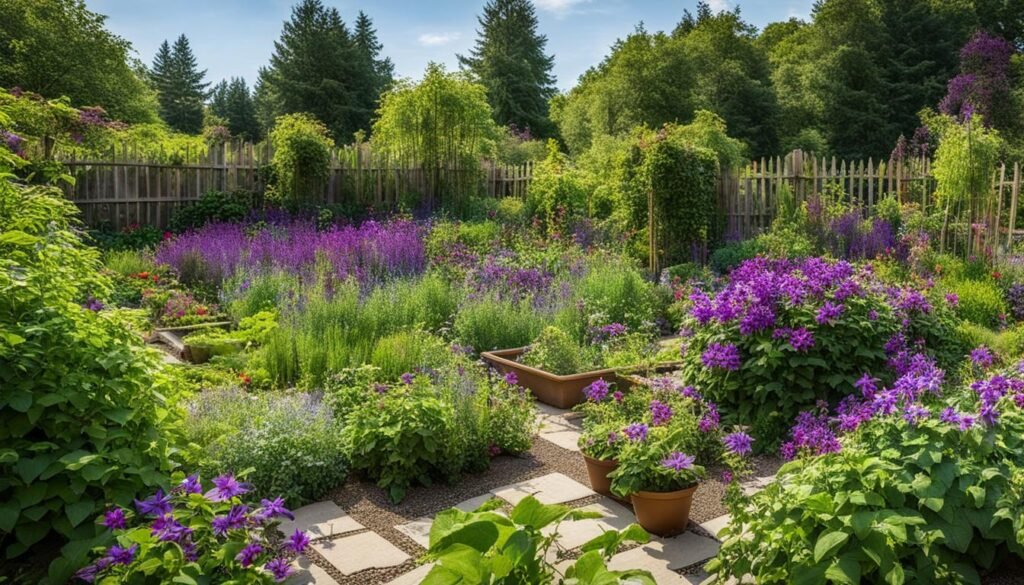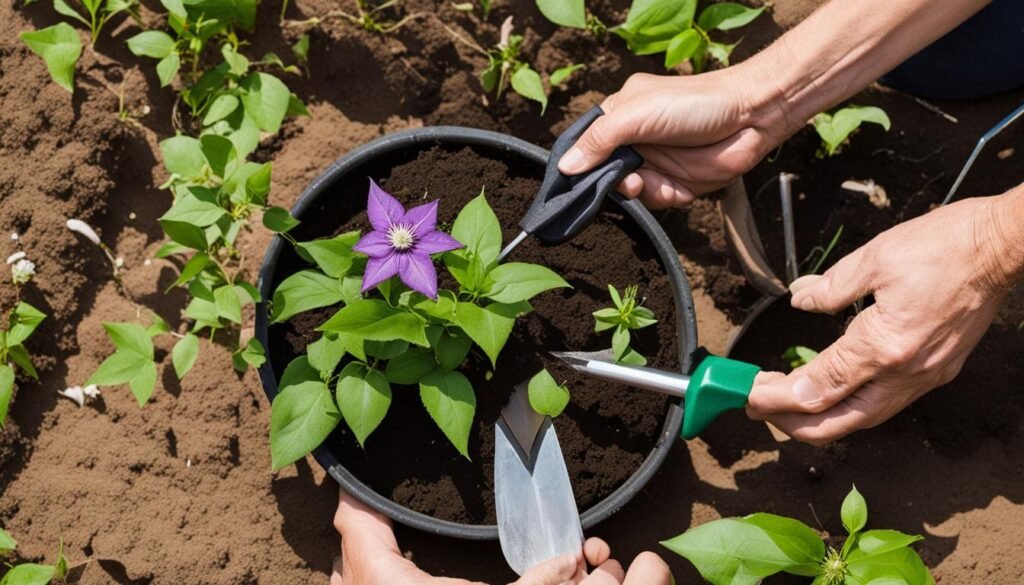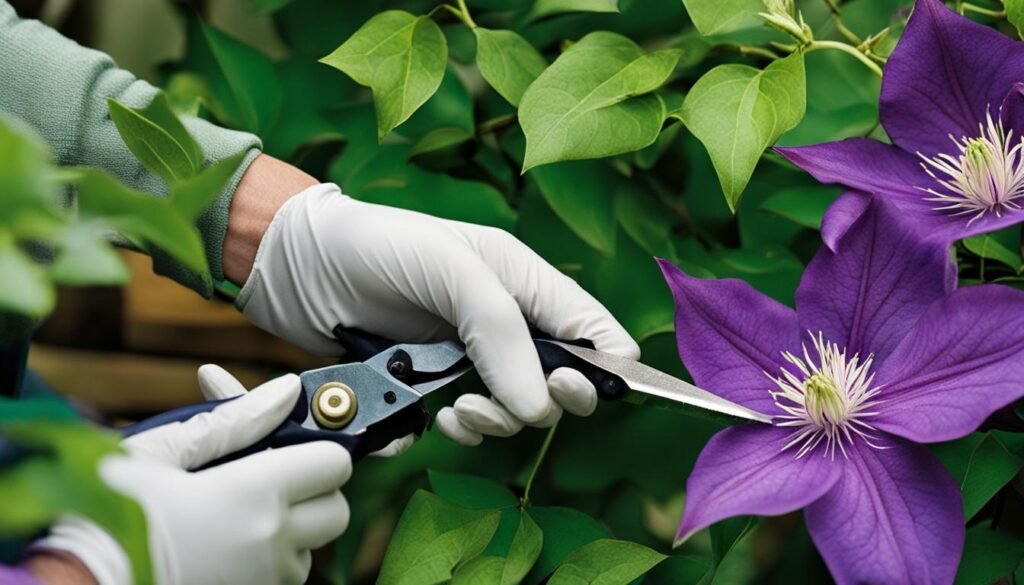As a passionate gardener, I’m always on the lookout for unique and stunning flowers to add to my garden. One variety that has captured my attention is the purple bell-shaped clematis. Picture this: a profusion of daintily dangling bell-shaped flowers in a rich violet-blue color with light lavender accents. It’s truly a sight to behold!
But it’s not just the visual appeal that makes the purple bell-shaped clematis so special. This climbing vine is a magnet for bees, butterflies, and hummingbirds, bringing life and movement to any garden. Whether you plant it as a ground cover or train it to climb a trellis, this clematis will reach a height of 7-8 feet, creating a breathtaking vertical display.
What I love most about the purple bell-shaped clematis is its continuous blooming from summer into fall. It’s a reliable performer that adds long-lasting color to your outdoor space. Plus, it thrives in various light conditions, from full sun to part shade, making it adaptable to different areas of your garden.
To ensure the best blooming, it’s crucial to provide organic matter at planting time and keep the soil consistently moist. With a little care and attention, your purple bell-shaped clematis will reward you with vibrant and enchanting blossoms.
Key Takeaways:
- Purple bell-shaped clematis is a stunning variety that features daintily dangling bell-shaped flowers in a rich violet-blue color.
- It attracts bees, butterflies, and hummingbirds, adding life and movement to your garden.
- This clematis can be grown as a ground cover or trained to climb a trellis, reaching a height of 7-8 feet.
- It blooms continuously from summer into fall and does well in full sun to part shade.
- Providing compost or organic matter at planting and keeping the soil consistently moist will result in the best blooming.
Choosing the Right Variety of Clematis
When selecting a purple bell shaped clematis or any clematis variety for your garden, it’s important to consider various factors to ensure the best fit. These factors include the desired mature height, flowering time, and preferred planting conditions. To make an informed decision, let’s explore some popular bell-shaped clematis varieties and their unique characteristics.
‘Nelly Moser’
‘Nelly Moser’ is a stunning clematis variety that blooms in late spring. It features large, star-like singles in a soft pink color. The delicate pastel hue of its flowers adds a touch of elegance to any garden. This variety is known for its robust growth and can reach a mature height of around 8 feet, providing a magnificent vertical element to your outdoor space.
‘Jackmanii’
If you’re looking for a vigorous climber with deep purple flowers, ‘Jackmanii’ is a fantastic choice. This clematis variety is a favorite among gardeners for its striking blooms that emerge in the summer. With a mature height of up to 10 feet, ‘Jackmanii’ creates a dramatic focal point, attracting attention and admiration from all who see it.
‘Henryi’
‘Henryi’ is another remarkable clematis variety that produces large white flowers with chocolate-colored stamens. Blooming in the summer, this variety adds a touch of sophistication and purity to your garden. With a mature height of approximately 9 feet, ‘Henryi’ creates an impressive display and complements a variety of color schemes and garden styles.
By carefully choosing a clematis variety that suits your taste and the landscape of your garden, you can ensure a beautiful and harmonious floral display. Consider the desired mature height, flowering time, and preferred planting conditions when making your selection.
| Variety | Flowering Time | Mature Height |
|---|---|---|
| ‘Nelly Moser’ | Late spring | Around 8 feet |
| ‘Jackmanii’ | Summer | Up to 10 feet |
| ‘Henryi’ | Summer | Approximately 9 feet |
Selecting the Ideal Location for Clematis
Purple bell shaped clematis is a sun-loving plant that thrives in locations with ample sunlight. It requires at least six hours of direct sunlight each day to ensure healthy growth and abundant flowering.
In addition to sunlight, the clematis also requires well-draining soil to prevent waterlogging and root rot. It is important to choose a planting location with soil that is enriched with organic matter and has a slightly alkaline pH. If your soil is naturally acidic, consider periodically sweetening it with limestone or wood ash to create optimal conditions for the clematis.
When selecting a location for planting, it is essential to provide a sturdy support structure for the clematis to climb on. This can be a trellis, arbor, or fence. The support structure should be strong enough to accommodate the growth of the vine and provide stability to prevent damage from wind or heavy rain.
To ensure the root zone of the clematis stays relatively cool, consider planting it next to shade-providing plants or mulching the soil. This will help maintain the ideal temperature and moisture levels for the plant’s roots.
By carefully selecting the ideal planting location for your purple bell shaped clematis and providing the necessary sunlight, well-draining soil, and support structure, you can create the perfect environment for this beautiful vine to thrive.

Clematis Planting Location Checklist:
- Plenty of direct sunlight, at least six hours per day
- Well-draining soil enriched with organic matter
- Soil with a slightly alkaline pH
- Consider sweetening acidic soil with limestone or wood ash
- Ample space for the vine to grow
- Provide a sturdy trellis, arbor, or fence for support
- Plant next to shade-providing plants or mulch to keep the root zone cool
How to Plant and Care for Clematis
Planting and caring for purple bell shaped clematis is relatively straightforward. Follow these steps to ensure the success and beauty of your clematis vine.
Soil Preparation
Before planting, it’s important to prepare the soil to provide optimal growing conditions for your clematis. Start by loosening the soil in the planting area. Adding compost or organic fertilizer can improve soil fertility and drainage. Incorporating well-rotted manure can also help enrich the soil.
Planting
Choose the best time to plant your purple bell shaped clematis, either in early spring or fall. Dig a hole that is twice the diameter of the root ball. Position the plant in the hole slightly deeper than it was in the pot, ensuring that the crown is around 1-2 inches below the soil surface. Backfill the hole with the native soil and water the plant thoroughly after planting.
Watering
Proper watering is crucial for the establishment and growth of your clematis vine. Water the plant regularly, especially during the first year, to help it develop a strong root system. Aim to keep the soil consistently moist, but be careful not to overwater, as excessive moisture can lead to root rot.
Mulching
Mulching is an effective technique for conserving moisture and maintaining cool soil temperatures, both of which are beneficial for clematis growth. Apply a layer of organic mulch around the base of the plant, taking care to keep the mulch a few inches away from the stem to prevent rotting. Mulching also helps suppress weed growth and adds organic matter to the soil over time.
Support Structure
Clematis vines are climbers and require a sturdy support structure to grow and flourish. Install a trellis, wire grid, or other appropriate support system that allows the vine to climb and expand. Make sure the support structure is in place before planting to avoid damaging the roots later on.
By following these planting and care guidelines, you can ensure that your purple bell shaped clematis thrives in your garden, delighting you with its stunning blooms. Enjoy the beauty and elegance of this remarkable flowering vine!
Supporting and Training Clematis
Purple bell shaped clematis requires a sturdy support structure to climb and flourish in your garden. To ensure the success of your vine, it is essential to provide it with a suitable clematis support structure such as a trellis, arbor, or fence.
The growing end of the vine has leaf stems that naturally wrap around the support. Therefore, it is important to provide a structure with a diameter of less than about 1/4-inch for the vine to grab onto. One effective option is to use wire grids with openings between 1″ and 4″ as a trellis for your clematis.
Regularly checking and adjusting the supports is important to prevent any damage caused by strong winds or heavy rain. By tying the vine to the support system using gentle ties or clips, you can guide its growth and ensure that it spreads properly.
Here is a summary of key points to remember for supporting and training your clematis vine:
Supporting and Training Clematis:
- Choose a sturdy clematis support structure such as a trellis, arbor, or fence.
- Provide a structure with a diameter of less than about 1/4-inch for the vine to wrap its leaf stems around.
- Consider wire grids with openings between 1″ and 4″ as an effective trellis option.
- Regularly check and adjust the supports to prevent damage from wind or rain.
- Tie the vine to the support system using gentle ties or clips for proper growth and spreading.
By ensuring proper support and training, you can create an enchanting display of purple bell shaped clematis in your garden.

Pruning Techniques for Clematis
Proper pruning is essential for maintaining the health and vitality of purple bell-shaped clematis. Understanding the different pruning groups of clematis is crucial to ensure effective pruning practices.
Group 1 clematis, which includes varieties that bloom on old wood, requires minimal pruning. These clematis typically produce flowers early in the growing season. Pruning should be limited to maintaining the desired shape and removing dead or weak stems.
Group 2 and Group 3 clematis, on the other hand, bloom on new wood and benefit from more extensive pruning. Purple bell-shaped clematis falls into this category, as it blooms on new growth. Pruning for these varieties can involve more aggressive measures to promote vigorous growth and abundant blooming.
The best time to prune purple bell-shaped clematis is in late summer, right after the plant has finished blooming for the season. This allows the plant to recover and prepare for the upcoming year’s growth.
Pruning Techniques for Purple Bell Shaped Clematis:
- Remove any dead, damaged, or weak stems to maintain a healthy and robust plant.
- Trim back any overgrown or tangled stems to improve the plant’s overall appearance.
- Shape the plant by selectively cutting back stems to achieve the desired form and size. This promotes a more attractive and well-balanced growth habit.
- Avoid pruning too heavily, as it may reduce the amount of blooms in the following season. It is recommended to only remove up to one-third of the plant’s total growth.
Remember, pruning purple bell-shaped clematis is not necessary for blooming, but it can be done to improve the plant’s overall health and appearance. By following these pruning techniques and considering the plant’s bloom type, you can ensure that your purple bell-shaped clematis thrives and continues to grace your garden with its beautiful flowers.

Doing Research on Clematis Varieties
Before choosing a clematis variety, it’s important to do some research to understand the different options available. Clematis varieties come in a wide range of heights, bloom times, flower forms, and colors. Some varieties can reach up to 20 feet in height, while others stay compact at around 3 feet. Flowering times can occur in late spring, summer, or fall, and some varieties re-bloom throughout the season. Flower forms vary from star-like singles to frilly doubles, miniatures, and bell-shaped blossoms. Colors range from white, pink, and red to burgundy, lavender, deep purple, and even yellow.
Doing thorough research on clematis varieties allows you to find the perfect fit for your garden. Consider the height of the plant, its bloom time and flower form, and the colors you prefer. Whether you want a towering vine with cascades of flowers or a compact variety for containers, understanding the options available helps you make an informed decision.
| Variety | Height | Bloom Time | Flower Form | Colors |
|---|---|---|---|---|
| Nelly Moser | 6-8 feet | Late spring | Star-like singles | Soft pink |
| Jackmanii | 8-12 feet | Summer | Bell-shaped | Deep purple |
| Hagley Hybrid | 6-8 feet | Summer | Single or semi-double | Pale pink |
| Princess Diana | 6-8 feet | Summer | Double | Red |
| Comtesse de Bouchaud | 8-12 feet | Summer | Large singles | Pink |
Notable Clematis Varieties
Nelly Moser: This variety stands out with its large star-like singles in soft pink, blooming in late spring. It grows to a height of 6-8 feet, making it a great choice for trellises or fences.
Jackmanii: Known for its deep purple bell-shaped flowers, Jackmanii is a vigorous climber that reaches a height of 8-12 feet. It blooms during the summer months, adding a pop of vibrant color to your garden.
Hagley Hybrid: With its delicate pale pink flowers, Hagley Hybrid is a charming addition to any garden. It grows to a height of 6-8 feet and blooms throughout the summer, attracting butterflies and hummingbirds.
Princess Diana: This clematis variety features double red flowers that add a bold splash of color to your garden. It reaches a height of 6-8 feet and blooms during the summer months.
Comtesse de Bouchaud: With its large pink flowers and a height of 8-12 feet, Comtesse de Bouchaud makes a striking statement in any garden. It blooms in the summer, creating a beautiful display of color.
By researching clematis varieties, you can discover the perfect combination of height, bloom time, flower form, and color to complement your garden design and personal preferences.

Choosing the Right Planting Location for Clematis
To ensure the success of purple bell shaped clematis or any clematis variety, it’s crucial to choose the right planting location. Consider the following factors when selecting the perfect spot for your clematis:
Soil Conditions
Clematis prefer well-drained soil that is rich and loamy. Before planting, make sure the soil is loose and friable. If the soil is heavy or clay-like, amend it with compost or organic matter to improve drainage and provide essential nutrients.
Sun Exposure
Clematis thrive in full sun, but some varieties can tolerate half-day sun or part shade. Ideally, they should receive at least six hours of sunlight per day. Be sure to choose a location that offers the appropriate sun exposure for the specific variety you are planting.
Container Growing
If you’re planting clematis in a container, ensure it has good drainage to prevent waterlogged roots. Use a large enough pot that can accommodate the vigorous growth of the clematis and provide ample space for the root system to develop. Choose a high-quality potting mix designed for container gardening.
Providing Support
Clematis are climbers and require a trellis, support structure, or container to climb on. Install a sturdy trellis or support system that is appropriate for the desired height and spread of your clematis. Make sure it is firmly anchored in the ground or securely attached to a wall or fence.
By considering factors such as soil conditions, sun exposure, and available space, you can choose the perfect planting location for your purple bell shaped clematis. Providing the right conditions will ensure healthy growth and abundant blooms.

How to Plant and Care for Clematis
Planting and caring for purple bell shaped clematis is essential to ensure its healthy growth and abundant blooms. By following proper techniques and providing the necessary care, you can enjoy the beauty of this stunning flowering vine in your garden. Here’s a step-by-step guide on how to plant and care for your purple bell shaped clematis:
1. Soil Preparation
Before planting your purple bell shaped clematis, prepare the soil to create optimal growing conditions. Start by loosening the soil in the planting area using a garden fork or tiller. This will improve drainage and allow the roots to penetrate easily. Add compost or well-rotted manure to enrich the soil with nutrients, ensuring healthy growth.
2. Planting
Choose a location that provides full sun to part shade for your purple bell shaped clematis. Dig a hole that is slightly larger than the root ball of the plant. Place the clematis in the hole and make sure the crown, the point where the stems emerge from the roots, is positioned 1-2 inches below the soil surface. Backfill the hole with soil and gently firm it around the roots. Water the plant deeply to settle the soil and remove any air pockets.
3. Watering
Proper watering is crucial for the establishment and growth of your purple bell shaped clematis. After planting, water the plant thoroughly and keep the soil consistently moist during the first year. This will help the roots establish and encourage healthy growth. As the plant matures, continue to provide regular watering, especially during dry periods.
4. Root Protection
Protect the young purple bell shaped clematis plant from nibbling animals, such as rabbits or deer, by surrounding it with wire mesh or fencing. This will prevent damage to the delicate stems and leaves, allowing the plant to grow undisturbed.
5. Trellis Installation
Install a trellis or support structure right from the start to ensure proper growth and climbing of your purple bell shaped clematis. Choose a sturdy trellis that provides enough space for the vine to grow and attach itself. Secure the trellis firmly in the ground or against a solid structure, keeping in mind the eventual height of the clematis. This will provide the necessary support for the vine to climb and showcase its beautiful bell-shaped flowers.
| Planting and Care Checklist |
|---|
| Loosen the soil and add compost or well-rotted manure to enrich it. |
| Position the crown of the clematis 1-2 inches below the soil surface. |
| Water deeply after planting and keep the soil moist during the first year. |
| Protect the young plant from nibbling animals by using wire mesh. |
| Install a sturdy trellis or support structure for the vine to climb. |
Following these planting and care instructions will help ensure the success and beauty of your purple bell shaped clematis. By providing proper soil preparation, watering, root protection, and installing a trellis for support, you can enjoy the graceful climb and stunning flowers of this captivating vine.

Providing Proper Support for Clematis
Clematis vines require a sturdy support structure to climb and grow properly. To ensure the health and beauty of your purple bell shaped clematis, it’s important to install a suitable trellis and provide regular maintenance.
- Choose a sturdy support: Wire grids with openings between 1″ and 4″ provide an effective trellis option for clematis vines. They allow the vine to grab onto the support and climb upwards.
- Secure trellis installation: Ensure the trellis is securely installed in the ground or against a wall. This will prevent it from toppling over or getting damaged during windy conditions.
- Tie the vine: Gently tie the clematis vine to the support system using soft ties or clips. Avoid using materials that can damage or constrict the growth of the vine.
- Regularly check and adjust supports: Regularly inspect the trellis and supports to ensure they are intact and properly positioned. Adjust any loose or displaced sections to prevent damage from wind or heavy rain.
- Maintain and shape the vine: Prune and trim the vine as needed to maintain its shape and prevent overgrowth. This will promote healthy growth and ensure an aesthetically pleasing appearance.
By providing proper support, conducting regular maintenance, and training the vine, you can help your purple bell shaped clematis thrive and flourish.
In the next section, we will discuss pruning techniques for clematis to further enhance their growth and blooming.
Pruning Tips for Clematis
Pruning plays a crucial role in ensuring the health and vitality of your purple bell shaped clematis. By employing the correct pruning techniques, you can promote abundant blooming and encourage vigorous growth. Here are some essential tips for successful clematis pruning:
Pruning Timing
The timing of clematis pruning is dependent on the blooming pattern of the variety you have. For clematis that primarily develop new growth on last year’s vines, it is best to prune after they finish blooming. This technique allows the plant to divert its energy towards the growth of new stems and flower buds.
For clematis varieties that set flowers on current year vines, it is recommended to prune them in early spring, just before the new growth begins. By cutting back the plant to a height of 12-18 inches, you encourage vigorous growth from the base and ensure a stunning display of blossoms.
If you have a clematis vine that requires rejuvenation due to overgrowth or decline in flowering, more drastic pruning may be necessary. In such cases, you can cut back the entire plant to a height of 5 inches in either fall or early spring. This rejuvenation pruning allows for renewed growth and the rejuvenation of your clematis.
Pruning Technique
The technique for pruning clematis varies based on the blooming pattern of the variety. For clematis that bloom on old wood, it is advisable to limit pruning to maintaining the desired shape and removing any dead, damaged, or weak stems. This minimal pruning helps preserve the existing structure and encourages future flowering.
If your clematis sets flowers on new wood, you can prune more extensively to shape the plant and remove any undesirable growth. To promote optimal growth and better access to sunlight, it’s recommended to thin out the center of the vine by selectively removing some stems.
Visual Representation
Here is a table summarizing the main pruning techniques for different clematis blooming patterns:
| Blooming Pattern | Pruning Technique |
|---|---|
| Blooms on old wood | Maintain shape, remove dead or weak stems |
| Blooms on new wood | Prune back to 12-18″ in early spring |
| Rejuvenation pruning | Cut back entire plant to 5″ in fall or early spring |

Remember, proper pruning not only enhances the overall appearance of your purple bell shaped clematis but also contributes to its long-term health and vitality. By following the appropriate pruning techniques and timing, you can enjoy a stunning and flourishing clematis vine in your garden.
Conclusion
Growing purple bell-shaped clematis can be a delightful addition to your garden, bringing beauty and vertical interest to your outdoor space. By following these gardening tips and care instructions, you can ensure that your purple bell-shaped clematis thrives and blooms brilliantly.
Firstly, it is essential to choose the right variety of clematis that suits your taste and preference. Whether you opt for the enchanting ‘Nelly Moser,’ the vigorous ‘Jackmanii,’ or the elegant ‘Henryi,’ there is a bell-shaped clematis variety to suit every garden.
Secondly, providing the proper planting location and support is crucial for the success of your purple bell-shaped clematis. Ensure that the planting area receives ample sunlight, has well-draining soil enriched with organic matter, and offers a sturdy trellis or support structure for the vine to climb upon.
Lastly, remember to follow pruning techniques suited for your clematis variety. Regular pruning will help maintain the desired shape, remove dead or weak stems, and promote healthy growth and abundant flowering.
With these gardening tips and care instructions in mind, your purple bell-shaped clematis will flourish, blooming with stunning bell-shaped flowers that bring joy and beauty to your garden. Happy gardening!
